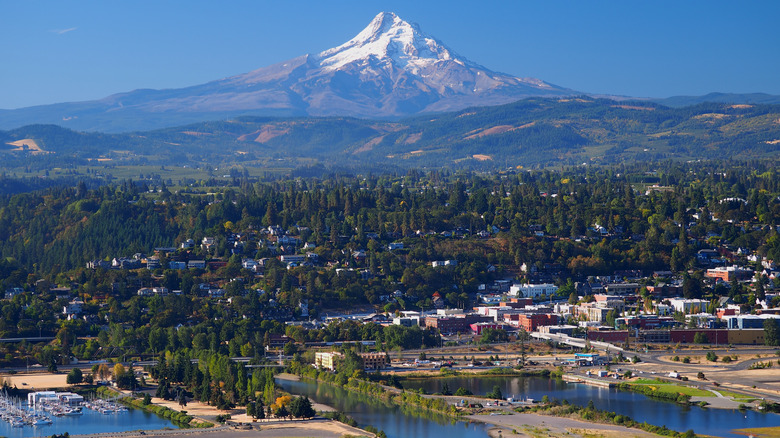The 'Windsurfing Capital Of The World' Is An Oregon Gem With Incredible Scenery
Cradled between Mount Hood's snow-tipped slopes and the churning Columbia River, Hood River feels like a place drawn from two different worlds: one of alpine stillness, another of windswept adventure. Just an hour east of Portland, this small riverfront Oregon town captures the spirit of the Pacific Northwest: misty mornings, orchard-lined hillsides, and an unhurried charm that makes you forget time entirely. Long before it became a magnet for windsurfers and weekend wine enthusiasts, Hood River was a valley of apple and pear farmers, a place where everything still feels tied to the land.
Every visit begins with the river. Out on the Columbia, the wind builds in steady pulses, carrying with it a sense of momentum that defines the town's culture. Hood River has earned its title as the windsurfing capital of the world, and even if you never step on a board, the sight of sails flashing like dragonflies across the water is unforgettable. The energy of the Gorge hums all around: the swoop of a kite, the shimmer of spray, the rhythm of the current as it presses against the basalt cliffs.
The Hood River Fruit Loop, a 35-mile drive through the valley's farms and vineyards, is the region's beating heart. In late-summer, the air fills with the scent of ripening pears; in autumn, apples blush on their branches and farm stands brim with cider, honey, and baked goods. The route meanders past lavender fields and tasting rooms where you can sip pinot noir with Mount Hood framed in the distance. For hikers and cyclists, the Columbia River Gorge offers a labyrinth of trails that weave through waterfalls, fir forests, and volcanic rock. You can start your morning with coffee downtown, hike a sunlit ridge by noon, and end the day back on the riverfront, watching the sky turn amber over the water. It's a way of life that Hood River teaches easily: adventure first, reflection after.
Eating and resting in style
Food in Hood River carries the same sense of intimacy as its landscape: unpretentious but artfully crafted. Riverside Restaurant, perched beside the river, plates seasonal Pacific Northwest fare with panoramic views of the water, while Solstice Wood Fire Café turns out some of the best pizza in Oregon, served alongside local beer. Downtown, Oak Street hums with cafés and wine bars that invite lingering. There's always live music somewhere, and always a view waiting just beyond the patio rail.
The places to stay mirror this balance of refinement and ease. Hood River Hotel, a 1912 landmark at the corner of Oak and First, feels like stepping back into a sepia photograph: creaky floors, wool blankets, and a lobby warmed by mismatched armchairs and the smell of espresso. Down by the river, Hood River Inn offers comfort with a touch of luxury, its rooms opening onto the water where the first rays of morning hit the sails of early surfers.
A sense of place in Hood River
Reaching Hood River is an experience itself. The drive along I-84 from Portland traces the Columbia River Gorge, one of the most beautiful corridors in the American West. Sheer cliffs rise on either side, waterfalls spill through ferns, and each curve reveals another postcard moment. Once you arrive, the town unfolds easily on-foot with colorful storefronts, vintage brick facades, and the steady sound of the river beyond.
Hood River's story is one of resilience and reinvention. Long inhabited by Native American tribes, the area later became home to settlers drawn by its fertile soil. The fruit orchards they planted still define the valley today, though now they share space with vineyards, breweries, and tech start-ups that have quietly made the town a magnet for young creatives. Its adventurous streak emerged in the late twentieth century, when the Gorge's fierce winds lured the world's best windsurfers and transformed the river into an outdoor stage.
Yet even with its growing fame, Hood River feels grounded, anchored in the rhythm of nature and the warmth of its community. You sense it at the farmers' market, in the easy conversation at a wine bar, or during a quiet moment looking out over the orchards. Here, wind, water, mountain, and fruit come together to compose something rare: a small town that feels vast.


